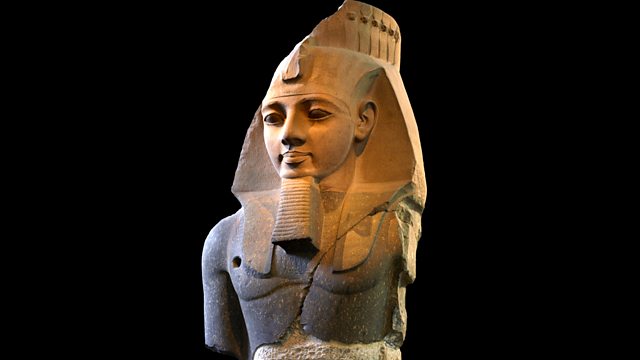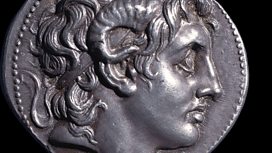Statue of Ramesses
Neil MacGregor explores the life and culture of ancient Egypt through the statue of Ramesses II that towers over British Museum visitors. Antony Gormley reflects on the work as art
A History of the World in 100 Objects has arrived in Egypt around 1250BC. At the heart of this programme is the British Museum's giant statue of the king Ramesses II, an inspiration to Shelly and a remarkable ruler who build monuments all over Egypt. He inspired a line of future pharaohs and was worshipped as a god a thousand years later. He lived to be over 90 and fathered some 100 children! Neil MacGregor considers the achievements of Ramesses II in fixing the image of imperial Egypt for the rest of the world. And the sculptor Antony Gormley, the man responsible for a contemporary giant statue, The Angel of the North, considers the towering figure of Ramesses as an enduring work of art.
Last on
More episodes
Next
You are at the last episode
![]()
More programmes from A History of the World in 100 Objects related to leaders & government
About this object
Location: Thebes, Egypt
Culture: Ancient Egypt
Period: About 1250 BC
Material: Stone
��
This statue of the Pharaoh Ramesses II was designed to show him as a beneficent ruler, a mighty warrior and a living god. It was erected in the Ramesseum - his mortuary temple, where the cult of Ramesses would continue for centuries. During his reign the annual Nile flood repeatedly reached ideal levels leading to good harvests and a period of prosperity in Egypt. Ramesses himself fathered 85 children with a number of queens during his 66-year reign.
Why was Ramesses II so successful?
Ramesses II is known as one of Egypt's greatest pharaohs - nine further pharaohs tried to emulate his success by taking his name. Although Ramesses was renowned as a warrior-king he suffered several military setbacks. Ramesses owed his reputation to his skills as a self-publicist - he erected more statues than any other Egyptian pharaoh. He even changed or added to the inscriptions on previous pharaohs' statues to glorify himself. This ensured that Ramesses was worshiped as a god for centuries after his death.
Did you know?
- The original complete statue weighed 20 tonnes, as much as 36 African Elephants.
Who was Ramesses II?
By Marcel Maree, Curator, British Museum.
��
This magnificent sculpture is the upper third of a colossal seated statue that represents Ramesses II, one of the most illustrious kings of ancient Egypt. He ruled his empire for almost 67 years during the thirteenth century BC.
Ramesses, determined to outshine all other pharaohs, called himself ‘ruler of rulers’ and had more monuments and statues created than any other pharaoh.
In the course of his long reign, Ramesses II had seven principal wives and fathered at least 40 daughters and 45 sons. Dying in his nineties, he outlived a dozen crown princes and was succeeded by his thirteenth son, Merenptah.
The twelfth century saw nine more kings with the name Ramesses come to the throne. They were increasingly weak, and during the reign of Ramesses XI the New Kingdom came to an end.
This statue was one of a pair that stood either side of a doorway in the king’s vast mortuary temple on the west bank of Thebes (modern Luxor). This temple was intended for the king’s posthumous cult.
Originally some nine metres tall, the statue was carved from a single piece of granite taken from a quarry 200 kilometres up the river Nile, at Aswan. It was deliberately extracted so that the head would be in red and the body in grey granite. The finer sculptural design was only carried out once the colossus had been erected inside the temple. Colour pigments, now mostly faded, were painted on to make the sculpture appear more lifelike.
How to move an object like Ramesses?
By Evan York, Museum Assistant, British Museum.
��
The bust of Ramesses II is one of the largest pieces of Egyptian sculpture in the British Museum and weighs over 7 tons.
When we move an object this large, a combined team of museum assistants and heavy object handlers would need to consider many aspects of where it is going to and the space available in which to move it.
When this statue of Ramesses was first brought into the Museum in the 1830s, a hole had to be made in the gallery wall and it was brought in using rope and wooden scaffolding.
Today, due to its size, we cannot lift the statue using equipment such as forklifts. Instead we can lift the object from above using steel gantries and slings (a modern equivalent of rope and wood).
We can also lift the statue from below. Large timbers are used to lower, or ‘rock’, the statue to the ground level where it is placed on heavy duty wheels or rollers.
Both of these processes are long and slow and need a lot of skilled staff and patience. For example, to lower the statue using timbers, you need to lift one side of the statue up and lower the timber by a couple of centimetres and then repeat the action on the other side. So it can take hours to move even a few centimetres!
Transcript
Broadcasts
- Fri 12 Feb 2010 09:45������̳ Radio 4 FM
- Fri 12 Feb 2010 19:45������̳ Radio 4
- Sat 13 Feb 2010 00:30������̳ Radio 4
- Fri 3 Jul 2020 13:45������̳ Radio 4
Featured in...
![]()
Leaders and Government—A History of the World in 100 Objects
More programmes from A History of the World in 100 Objects related to leaders & government
Podcast
-
![]()
A History of the World in 100 Objects
Director of the British Museum, Neil MacGregor, retells humanity's history through objects





